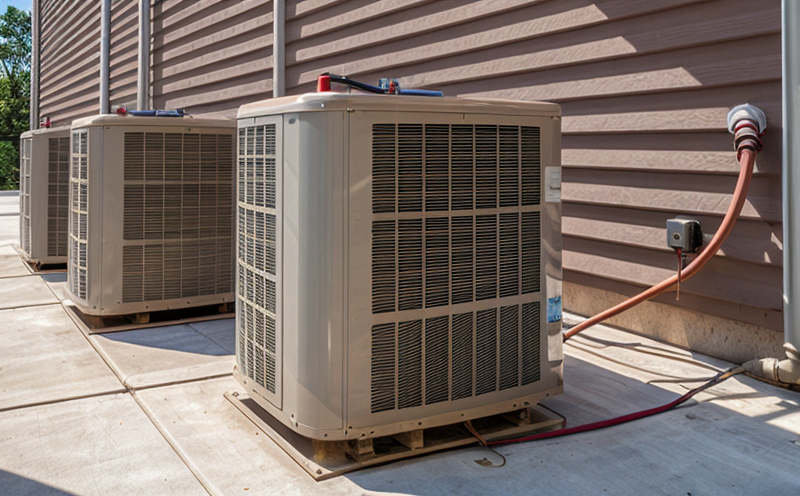EN 14825 Seasonal Energy Efficiency Rating
The EN 14825 standard is an important tool in the European Union's (EU) commitment to improving energy efficiency and reducing carbon emissions. This standard provides a method for calculating the seasonal energy efficiency rating (SEER) of heating, ventilation, air conditioning (HVAC), and refrigeration systems used in buildings. The SEER is calculated by considering both cooling and heating operations over a typical year. It allows for an apples-to-apples comparison between different HVAC systems, helping building owners, designers, and operators make informed decisions about energy-efficient equipment.
The standard applies to all types of HVAC systems installed in residential and non-residential buildings, including air conditioning units, heat pumps, and packaged terminal air conditioners. It is particularly relevant for large commercial facilities where the impact of inefficient HVAC systems on overall building energy consumption can be significant. The goal of EN 14825 is to ensure that all HVAC systems are as efficient as possible throughout their operational life.
Testing according to EN 14825 involves simulating real-world operating conditions in a controlled environment. This includes varying the outdoor air temperature, humidity levels, and indoor load requirements to accurately reflect how the system will perform under different climate conditions. The test typically takes place over a period of several days, during which time the system's performance is continuously monitored using high-precision instruments.
The results of these tests are used to calculate the SEER value for each system. This value represents the ratio of output energy (in kilowatt-hours) produced by the HVAC system compared to the input energy required to operate it over a given period. A higher SEER indicates greater efficiency, which is crucial for minimizing operational costs and reducing environmental impact.
Understanding and optimizing the SEER rating of your building's HVAC systems can lead to significant cost savings. By choosing equipment with high SEER ratings, you not only reduce energy consumption but also extend the lifespan of the system by operating it more efficiently. This is especially important in areas where extreme temperatures are common, as it helps maintain comfort levels while minimizing resource usage.
EN 14825 certification can enhance your building's reputation and attract eco-conscious clients or tenants. Many modern buildings aim to achieve LEED (Leadership in Energy and Environmental Design) certification, which recognizes energy-efficient facilities. Achieving compliance with EN 14825 is a key step towards meeting these standards.
| Industry Applications | Description |
|---|---|
| Air Conditioning Systems | Testing of air conditioning units to ensure they meet the required SEER rating for efficiency. |
| Heat Pumps | Evaluation of heat pumps installed in buildings, focusing on their seasonal performance. |
| Packaged Terminal Air Conditioners | Detailed testing and certification of these systems to ensure they meet the standards set by EN 14825. |
Accurate testing is crucial for ensuring compliance with EN 14825. Our laboratory uses state-of-the-art equipment and follows strict protocols to provide reliable results. We offer comprehensive testing services that cover the entire range of HVAC systems, providing you with detailed reports that can help optimize your building's energy efficiency.
Benefits
Compliance with EN 14825 offers numerous benefits for stakeholders involved in the design and operation of buildings. These include:
- Cost Savings: Reduced energy consumption leads to lower utility bills.
- Sustainability: Decreased reliance on fossil fuels contributes to a greener environment.
- Regulatory Compliance: Ensures adherence to EU environmental regulations, avoiding potential fines or penalties.
- Market Advantage: Promotes your building as an eco-friendly option in the competitive real estate market.
In addition to these tangible benefits, there are also intangible advantages such as enhanced reputation and increased tenant satisfaction. Clients appreciate knowing that they are part of a sustainable initiative, which can lead to improved occupancy rates and longer lease periods.
Industry Applications
| Application | Description |
|---|---|
| Residential Buildings | Evaluation of HVAC systems in residential properties to ensure they meet energy efficiency standards. |
| Commercial Buildings | Detailed testing and certification for large commercial facilities, including office buildings, hotels, and retail spaces. |
| Public Buildings | Evaluation of HVAC systems in public institutions like schools, hospitals, and government offices. |
| Manufacturing Plants | Testing of HVAC systems in industrial settings to ensure they operate efficiently despite challenging environmental conditions. |
The standard is particularly relevant for large commercial facilities where the impact of inefficient HVAC systems on overall building energy consumption can be significant. By ensuring that these systems meet EN 14825 requirements, you contribute to reducing your carbon footprint and improving sustainability efforts.
Use Cases and Application Examples
- New Construction: Ensuring all HVAC systems installed in new buildings meet the required SEER rating before occupancy.
- Retrofitting: Upgrading existing HVAC systems to improve their efficiency and compliance with current standards.
- Renovation: Evaluating the impact of renovations on the overall energy efficiency of a building's HVAC systems.
- Building Commissioning: Verification that all installed HVAC equipment is functioning correctly and meets performance expectations.
| Application Examples | Description |
|---|---|
| Office Building HVAC System Upgrade | An office building in a cold climate underwent an upgrade of its HVAC system to meet EN 14825 standards. The new systems were installed, and the SEER ratings were tested under various climate conditions. |
| Hotel Air Conditioning Retrofit | A luxury hotel sought to improve its environmental impact by retrofitting its air conditioning systems. Testing was conducted to ensure compliance with EN 14825 before installation. |
| Residential Development HVAC Commissioning | A large residential development aimed to achieve LEED certification and commissioned our laboratory for testing all HVAC systems installed in the project. |
These examples illustrate how EN 14825 plays a crucial role in various phases of building construction, renovation, and maintenance. Ensuring compliance with this standard helps maintain high standards of energy efficiency across different sectors, contributing to overall sustainability goals.





